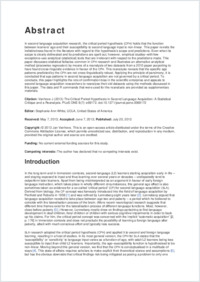The Critical Period Hypothesis in Second Language Acquisition : A Statistical Critique and a Reanalysis
BLE-BLL
- Vanhove, Jan Université de Fribourg
-
2013
Published in:
- Plos One. - 2013, vol. 9, no. 7, p. e102922
critical period hypothesis
second-language acquisition
statistical fallacies
reanalysis
piecewise regression
English
In second language acquisition research, the critical period hypothesis (CPH) holds that the function between learners' age and their susceptibility to second language input is non-linear. This paper revisits the indistinctness found in the literature with regard to this hypothesis's scope and predictions. Even when its scope is clearly delineated and its predictions are spelt out, however, empirical studies–with few exceptions–use analytical (statistical) tools that are irrelevant with respect to the predictions made. This paper discusses statistical fallacies common in CPH research and illustrates an alternative analytical method (piecewise regression) by means of a reanalysis of two datasets from a 2010 paper purporting to have found cross-linguistic evidence in favour of the CPH. This reanalysis reveals that the specific age patterns predicted by the CPH are not cross-linguistically robust. Applying the principle of parsimony, it is concluded that age patterns in second language acquisition are not governed by a critical period. To conclude, this paper highlights the role of confirmation bias in the scientific enterprise and appeals to second language acquisition researchers to reanalyse their old datasets using the methods discussed in this paper. The data and R commands that were used for the reanalysis are provided as supplementary materials.
- Faculty
- Faculté des lettres et des sciences humaines
- Department
- Département de plurilinguisme et didactique des langues étrangères
- Language
-
- English
- Classification
- Language, linguistics
- License
- License undefined
- Identifiers
-
- RERO DOC 141310
- DOI 10.1371/journal.pone.0069172
- Persistent URL
- https://folia.unifr.ch/unifr/documents/303230
Other files
Statistics
Document views: 221
File downloads:
- Critical_Period_Hypothesis.pdf: 282
- DeKeyser2010Israel.csv: 27
- DeKeyser2010NorthAmerica.csv: 40

